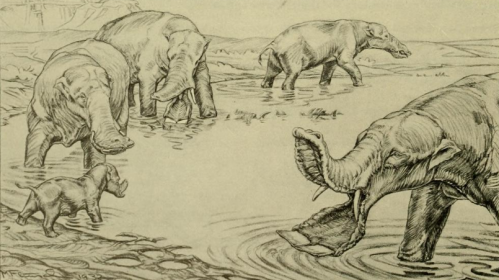Osborn’s reconstruction of Platybelodon from his 1936 book Proboscidea. Credit: American Museum of Natural History, via the Biodiversity Heritage Library/Wired
(Phys.org) —Noted paleontologist William Sanders of the University of Michigan has suggested via email to Matt Simon of Wired Magazine, that earlier depictions of platybelodon with a gaping mouth are likely misrepresenting what the ancient elephant-like animal actually looked like.
By most standards, the platybelodon was an odd looking animal—while resembling modern elephants, it also had a protruding lower jaw with horizontal teeth that Sanders believes were used in a scythe-like manner to mow down grass for consumption. Platybelodon fossils were first discovered and described back in the early 1920's. Since that time, many more fossils (particularly in China) have been found helping to give researchers a better picture of what the animal actually looked like. It's now pretty clear that they lived approximately 8 to 20 million years ago in Africa, Asia and even made their way to North America. But because their upper mouth region, snout or trunk, was made of softer material that didn't fossilize very well, researchers have not been able to see what the upper part of the mouth or trunk actually looked like. For that reason, they have had to put forth theories to explain why an animal would grow a lower jaw the way it did and how an upper mouth or trunk might make best use of what it had—otherwise, neither would have evolved the way it did.
The earliest depictions of platybelodon show an elephant-like creature with a dexterous upper mouth and large, equally dexterous tongue. The thinking, by one of the first to try to understand how the animal looked—Henry Osborn—was that platybelodon simply used its mouth parts to grab food and eat it, much like most other grazers. Paleontologist David Lambert, suggested back in 1992, however, that careful study of the teeth on the bottom jaw indicated the animal used them for slicing grass, a feat which would have been difficult for a simple normal grazer. Now, Sanders is weighing in, suggesting that the answer is simple—platybelodon had a trunk like modern elephants, but rather than simply using it to yank food from the ground to stuff into its mouth, it used it to hold onto thick tough grasses while sawing with its lower teeth. That would explain, he says, why the trait evolved—it was a way to help feed a large animal that had to subsist on grass that was too tough to simply yank from the ground.
© 2013 Phys.org






















